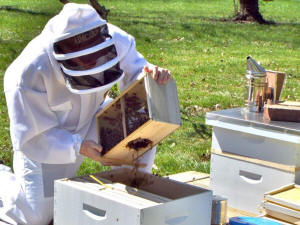|
 Before you take the plunge, there are some things
to consider. First, you need to have some basic knowledge before you
become a beekeeper. There are literally thousands of youtube videos
online on every facet of beekeeping, many of which are aimed at the
new beekeeper (if you click on the gear, you can adjust the speed to
optimize your time). They are usually short and often are about a
single facet of beekeeping. They show you in a hands-on way what to
expect and how things are done. There are also many good books
written on the subject, and they are a good reference for all the
issues you will face. Watch as many videos as you can and check out
some of the beekeeping books at your local library before you decide
you will become a beekeeper. Since spring is the time you can obtain
your bees, then you have all winter to do your research. Before you take the plunge, there are some things
to consider. First, you need to have some basic knowledge before you
become a beekeeper. There are literally thousands of youtube videos
online on every facet of beekeeping, many of which are aimed at the
new beekeeper (if you click on the gear, you can adjust the speed to
optimize your time). They are usually short and often are about a
single facet of beekeeping. They show you in a hands-on way what to
expect and how things are done. There are also many good books
written on the subject, and they are a good reference for all the
issues you will face. Watch as many videos as you can and check out
some of the beekeeping books at your local library before you decide
you will become a beekeeper. Since spring is the time you can obtain
your bees, then you have all winter to do your research.

Tips for
Getting Started in Beekeeping
Second, as a beekeeper you need to expect to get stung by bees (no
beekeeper likes to get stung, and you never get used to it). It is
not unusual for a beekeeper to get stung at least once a month
whether wearing protective gear or not. It comes with the territory!
Bees, for the most part are passive, gentle and docile, but they are
protective. Your job as a beekeeper is to manage their efforts, keep
the hive in order, ward off disease, provide for them when natural
supplies are short, and help them be successful. That means that you
have to invade their territory and their home, do things that they
don’t approve of, and every once in a while cause some of the bees
to die an untimely death. None of your tasks are meant to harm them
but the bees often take offense. If you can’t stand the idea that
you will be stung (and members of your family may be stung too) then
maybe beekeeping is not for you.
Happy Bees and
Oh Crap I Got Stung... Again Third,
beekeeping may not be popular with your neighbors. A healthy hive
may consist of upwards of 30,000 bees. Your bees will go out from
the hive into your neighborhood foraging for nectar, pollen, water,
and tree sap to support the hive. They will visit your neighbor’s
swimming pool or birdbath for water. They will visit your neighbor’s
flowers for nectar and pollen. They will visit your neighbor’s pine
and poplar trees to collect sap to reinforce the hive. Your decision
to become a beekeeper involves your neighbors because they too may
get stung (and some of them may be allergic to beestings), so it is
best to locate your hives well away from neighboring houses and
gardens, and to discuss with your neighbors your plans to bring bees
to the neighborhood.

How to be a
beekeeper not a bee-haver Fourth,
beekeeping is challenging in this area. It is said that only 40
percent of beehives survive our winters despite best informed
efforts. That means if you have three hives, it is likely that you
will lose 1 or 2 whole hives each winter. You have to be emotionally
prepared for the losses and not take it personally. If we have a
harsh winter, then the bees stand the chance of freezing to death in
the hive. If we have a mild winter, the bees can be too active, run
out of food and starve. Viruses and fungus diseases can kill them
when they are stressed. As you do your research watching videos and
reading books, you will learn about the various causes of hive
death, practices to prevent it, how to propagate new hives, and how
to start all over.
(2/19/2017)
Nosema Killed My Bees - Explanation
Finally, beekeeping can be expensive. There are things you must buy
to be a beekeeper, some you can make, and some other things that are
optional. You can easily get carried away (it is often compared to
photography because of the costs and depth you can become involved).
The first thing you need to decide if you are going to take the
plunge is how many hives you are going to start with. Since the
winter mortality rate is 40%, then the recommended minimum is to
start with two hives. This gives you the chance to compare how the
hives are doing, and gives you resources to transfer from hive to
hive.
Did My Bees
Survive Winter?

It is recommended that you get a ventilated full body
suit with veil and gloves to work in the hives, costing about $150
or more.
[to top of second column] |
 You will see videos on youtube of beekeepers who
do not wear gloves or suits. Do not follow their example. The result
is that they get stung more often (getting stung in the face is a
real experience). You will need a smoker, a hive tool, and a brush.
These things should cost about $75.00.
Protective
Beekeeping Clothing...Part 3 Of Basic Beekeeping
A full hive consists of these wooden parts: a full
deep that will serve as the brood box, a medium that will serve as
the honey box, a bottom board, an inner cover and a telescoping top
cover. Inside the brood box and the honey box are hive frames for
the bees to build honeycomb on. The hive boxes should be painted on
the outside to prevent rot. A full hive consisting of these parts
should cost about $140, but there are plans out there to make your
own hives if you choose. Beehives and beekeeping equipment are
available locally at
Big R
in Lincoln.
Beekeeping 101
Hive Components And, of course, you
need to buy bees. There are two ways to purchase a productive hive
of bees. You can buy a 3 pound package of bees (there are about
10,000 bees in a 3 pound package) that includes a mated queen for
about $130. Packages are generally assembled in the southern states
and shipped here. So the bees you receive in a package have no idea
what a central Illinois winter is or how to survive the cold.

Sasse’s Apiary has packages
of bees for sale in May of each year.


How to install
a package of honey bees Another
method of obtaining bees is to buy what is called a “Nuc” from a
local beekeeper. A nuc (short for nucleus) includes frames with
honeycomb and is a fully functional hive when you receive it. Since
it comes from a local beekeeper, it may have a better chance of
surviving the local winters. Nucs also run about $130, but may give
you a better chance wintering in this area.
Buying A
Nucleus Hive Vs Packaged Bees There
are two big payoffs in beekeeping. First there is the satisfaction
and learning that you get from having bees and observing them. They
are very interesting creatures. Secondly, your hives will produce
honey that you can eat, share with your neighbors, or even sell.
Beekeeping is cool and can be a real “sweet” hobby.

Flow Hive
Honey Harvesting
|